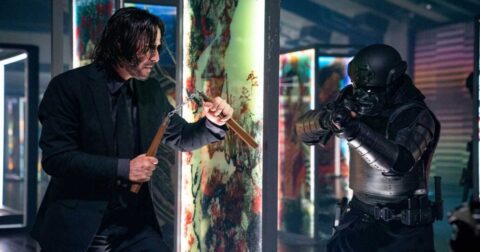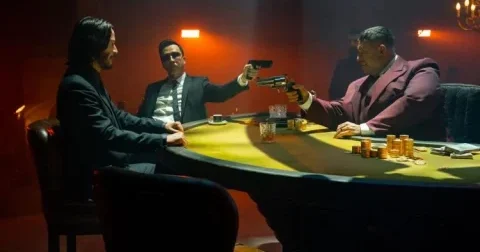John Wick: Chapter 4 (2023)
Directed by: Chad Stahelski
Written by: Michael Finch, Shay Hatten
Starring: Donnie Yen, Ian McShane, Keanu Reeves, Shamier Anderson
USA
IN CINEMAS NOW
RUNNING TIME: 169 mins
REVIEWED BY: Dr Lenera

In New York City, John Wick prepares to exact his revenge against the High Table while hiding underground with the Bowery King. He travels to Morocco and kills the Elder, but the Marquis Vincent de Gramont – a senior member of the High Table – strips Winston of his duties as manager of the Continental hotel, has the place destroyed, and executes Charon. He then enlists two men to kill John; blind, retired High Table assassin and old friend of John’s Caine whose daughter he will kill if he doesn’t agree to do the job, and contract killer the Tracker. Winston suggests that John challenge de Gramont to a duel, as winning will free him of his obligation to the High Table, but , as per the Table’s traditions, he can only request this on behalf of a crime family….

The John Wick series is an odd one in that each film is a little bit better than the one which came before it. 2014’s John Wick certainly made an impact, but the creators seem to be totally hellbent on topping what they’ve done before. As the universe in which the films take place is expanded and more and more action is put in, each installment is also bigger and longer, things which don’t automatically indicate an increase in quality and which sometimes actually mean the opposite, but which seem to really work here. John Wick: Chapter 4 runs nearly three hours [and director Chad Stahelski’s first cut was nearly an hour longer with editor Nathan Orloff being supposedly the one who cut the film down to its present running time], and a good amount of that running time is taken up with lengthy orgies of throwing, punching, kicking and shooting in a variety of locations. You could say, with some justification, that the movie is actually little more than one big orgy of throwing, punching, kicking and shooting in a variety of locations, though there’s certainly a decent story line which engages in more building of its fascinating world and gives us a character who manages to be just as compelling as John himself [in fact he actually may be more so], while the whole thing looks magnificent; is this the best photographed action movie in a very long time, with every effort made to make the most out of its settings? But then again this might just be the best action movie full spot in a very long time too, at least in terms of Hollywood productions. Watching it in the cinema, old Doc got some of the same exhilaration he got when he first discovered Hong Kong action movies in the early ’90s and was totally wowed by what they were offering which was really was on another level! Yes folks, John Wick: Chapter 4 is that good.
So our John wasn’t shot dead by Winston at the end of the third movie, and I wished at the time of watching and still wish now that we hadn’t been shown this. We see John falling off the edge of the building to the street below and Winston re-assuming his position as the High Table, which would have ended things on a downbeat but also somewhat ambiguous note fitting for what we were told was the final part of a trilogy. But of course plans for the next episode were no doubt being cooked up, so we had the severely injured John secretly delivered to the Bowery King in an underground bunker, the two then agreeing to join forces against the High Table. And this is where we rejoin them, John practicing his punches which really do pack an aural -well – punch so be prepared. We then cut to the deserts of Morocco and a horseback chase with gun-play as John pursues three others. You’ll recall that the Elder is the only person to be above the High Table and that, in their last encounter, John severed his ring finger and gives his wedding ring to The Elder to show his fealty. But now John has come purely to kill, which he does with ease. This causes the anger of the Marquis Vincent de Gramont who doesn’t just want to kill John, he wants to kill the legend of John. First things first though. After he shoots dead Charon which is a rather sad moment, he blows up the Continental, the important underworld locale in New York, and the explosion is only seen in the background, not up close, in a rather nice touch. John takes refuge at the Osaka Continental, run by his friend Shimazu Koji, though he’s not welcomed by Shamazu’s daughter Akira, because she knows that wherever John goes, trouble follows, and sure enough trouble soon arrives in the form of a group of assassins from de Gramont who’ve been sent to kill John, though Akira and Koji also get in the thick of it, especially Koji who’s more lethal with a bow without any arrows than with, though she then sadly disappears from the proceedings.
After a brief break with Winston, John decides to request this duel, but can only do so n behalf of a crime family, so, seeing as he previously severed his ties to the Ruska Roma, he travels to Berlin to rejoin the syndicate where his adoptive sister Katia agrees to bring John back in exchange for him killing somebody for her. However, on his trail are two people. The first we see is The Tracker, who’s contracted to kill John by de Gramont but when he has the opportunity to attempt to do so, lets him go because he’s decided that the contract money is insufficient. He then returns to de Gramont and asks for more, but de Gramont doesn’t like such arrogance. The Tracker, who has a dog in what’s virtually a reprise of an aspect of part three, follows John but it’s in his interest to keep John alive to increase the payday for his death. His character arc might be predictable but it being aided by what’s basically a reference to the first film is a nice touch, in this universe, dogs are not just very important but very influential. Shamier Anderson has presence in the role, but he’s undoubtedly overshadowed by the incredible screen martial artist Donnie Yen in the role of Caine, a sort of modern day variant of Zatoichi the Blind Swordsman but also a tragic person whom we feel for because he’s being forced to do this new job. At the Osaka Continental, he pauses to scoff down some food he grabbed in the hotel kitchen before letting rip. What a strong actor he’s now become since the likes of the recently reviewed by me In The Line Of Duty 4 in which he’s not good at all, here playing a sight-impaired person with restraint yet also totally relaxed and graceful in portraying comedic aspects of his character in what’s the most humorous film in the series so far, but with the chuckles perfectly placed, like a funny Mexican standoff moment where for a moment we’re invited to consider the absurdity of the situation and the actions of the people involved. Sometimes they’re even mingled into the action, such as when John fights his way to the top of lots of steps – and is then knocked down so he rolls all the way back down them and has to start again.

By the time that moment has come around, the action has reached heights of almost sublime brilliance, leaving us marveling at the brutal ballet of movement and power which Stahelski, who prefers to choreograph action himself rather than leave the job to others, has put up on the screen.In addition to his ability to merge martial arts and gun-play in a way so it seems believable, Stahelski has also managed to do something that’s quite remarkable in terms of Hollywood film-making – create action which manages to come across as elaborately put together yet also urgent and messy at the same time, and of course without any of the shaky-cam, flash cut stuff which thankfully seems to be lessening in terms of usage in films these days, even allowing for lots of long takes including an absolutely glorious moment where the camera of cinematographer Dan Laustsen rises up and looks down upon John going into several rooms dispatching heavy after heavy. At times the visual backgrounds are almost a character in themselves. At the Osaka Continental, lengthy sequences of mass combat involving John plus several other characters take place in a museum room with exhibits in glass cases and paintings, then a massive brown-yellow art deco foyer. Later on, John has fights a makeup-covered Scott Adkins and his bunch of henchmen in a crowded nightclub. It’s absurd that the dancers don’t seem bothered, sometimes parting to let the combatants through, sometimes stopping and staring before going back to dancing, but, along with water pouring into the club, the writhing, bodies make for such a visually strong backdrop that we don’t really mind. Eventually, in one of the most stunning action scenes in American cinema, a scene which could have been incoherent, our hero, his changing location being revealed by a DJ in a probable homage to a similar character in The Warriors, battles an inexhaustible supply of villains in the traffic circle around the Arc de Triomphe while appropriate needle drops play on the radio channel. He’s hit by cars several times and the drivers of other cars don’t seem to notice except some a few pauses, but this seems more like a deliberate, thought through decision, even if it does hamper plausibility.
In fact throughout it’s almost as if the world which John, Winston, Caine etc. inhabit, and the world that we live in, exist separately for the most part to sometimes intersect, like two different dimensions occasionally throwing up invisible portals for brief crossovers. Meanwhile the dialogue from screenwriters Shay Hatten and Michael Finch, who are both new to the franchise, has its share of good lines [“second chances are the refuge of men who fail“], and we’re given much more sense of Wick being a man who will maybe never be able to escape a violent life, indeed it’s why he exists. This is of course a familiar idea in movies though it hasn’t been employed that often in recent years. Reeves, who adds some emotional exhaustion to his character while being extremely generous [some may say to too generous but isn’t the fact that Wick remains a bit mysterious part of his appeal?] in allowing those around to shine, has very little dialogue in this one and much of it consists of “yeah”, yet the name “John Wick” amusingly shows up everywhere and in a variety of formats. Some obvious references to other films will be easily picked up on, but they don’t really stick out. When John finds himself at a deserted underground train station, we smile at the similarity to a scene in another franchise where Reeves was in a similarly deserted underground train station, but aren’t distracted in any real way. The hamming up of Bill Skarsgård as de Gramont, a villain so sure of himself that he can has a base right in one of the galleries of the Louvre, seems very appropriate, while Ian McShane and Laurence Fishburne share such chemistry in their few scenes together that we’d watch them in a spinoff devoted solely to their characters. However, women are given short shrift in this one, with even Katia only appearing for two scenes, but we’re frequently reminded of John’s wife Helen.
There’s less use of the familiar red and blue neon theme, and when it is used it’s often not as strong, but Laustsen is able to make virtually every scene interesting to look at anyway, such as one of the most beautiful candle- lit churches you will ever see. The music score from Tyler Bates and Joel J. Richards, as before, employs techno and rock elements that certainly help to propel the thrills along, though it’s a shame that Wick hasn’t been given a proper and memorable theme heard across all four films to be associated with. Nonetheless, way, way before a duel takes place where we want both participants to win, and which is bathed in a gorgeous sunrise, John Wick: Chapter 4 has shown us exactly why the action genre deserves to be respected and taken seriously, and the artistic peaks to which it can reach, in addition to proving that overkill can sometimes be a very good thing. However, being as it’s the latest part of a series where, as I said at the start of this review, each sequel improves on the film before it, there’s now a big problem. How the hell do they top this? That’s a challenge that even John Wick may find very hard to overcome.
Rating: 














Be the first to comment